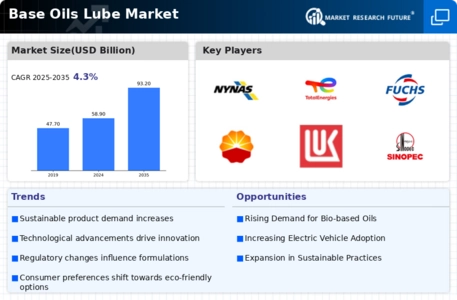Market Growth Projections
The Global Base Oils Lube Market Industry is projected to experience steady growth over the coming years. With a market value of 58.9 USD Billion in 2024, it is expected to reach 93.2 USD Billion by 2035, reflecting a compound annual growth rate (CAGR) of 4.27% from 2025 to 2035. This growth trajectory indicates a sustained demand for base oils across various applications, including automotive and industrial sectors. The increasing focus on performance, sustainability, and regulatory compliance will likely drive innovation and investment in the market, shaping its future landscape.
Growing Demand for Automotive Lubricants
The Global Base Oils Lube Market Industry experiences a robust demand for automotive lubricants, driven by the increasing number of vehicles on the road. As of 2024, the market is valued at approximately 58.9 USD Billion, reflecting the necessity for high-quality lubricants to enhance vehicle performance and longevity. The automotive sector's shift towards advanced engine technologies necessitates the use of superior base oils, which are integral in formulating high-performance lubricants. This trend is expected to continue, as consumers increasingly prioritize vehicle maintenance and efficiency, thereby propelling the market forward.
Industrial Growth and Manufacturing Expansion
Industrial growth plays a pivotal role in shaping the Global Base Oils Lube Market Industry. The expansion of manufacturing sectors, particularly in emerging economies, drives the demand for industrial lubricants. These lubricants are essential for machinery operation, ensuring efficiency and reducing wear and tear. As industries evolve, the need for specialized lubricants tailored to specific applications becomes apparent. The anticipated growth in manufacturing output is likely to contribute to the market's expansion, with projections indicating a market value of 93.2 USD Billion by 2035. This growth underscores the critical role of base oils in supporting industrial operations.
Technological Advancements in Lubricant Formulation
Technological advancements significantly influence the Global Base Oils Lube Market Industry, particularly in lubricant formulation. Innovations in refining processes and the development of synthetic base oils enhance the performance characteristics of lubricants, such as thermal stability and viscosity index. These advancements enable manufacturers to produce high-quality products that meet stringent regulatory standards and consumer expectations. As the market evolves, the integration of cutting-edge technologies is likely to drive growth, as companies strive to offer superior products that cater to diverse applications across various sectors, including automotive and industrial.
Rising Demand for Renewable and Bio-based Lubricants
The rising demand for renewable and bio-based lubricants is a notable trend within the Global Base Oils Lube Market Industry. As sustainability becomes a priority for consumers and businesses alike, the market for bio-based lubricants is expanding. These products, derived from renewable resources, offer comparable performance to traditional lubricants while minimizing environmental impact. The increasing focus on reducing carbon footprints and promoting sustainable practices is likely to drive the adoption of bio-based lubricants. This trend not only aligns with global sustainability goals but also presents opportunities for innovation and growth within the market.
Regulatory Compliance and Environmental Considerations
Regulatory compliance and environmental considerations are increasingly shaping the Global Base Oils Lube Market Industry. Governments worldwide are implementing stringent regulations to minimize the environmental impact of lubricants, prompting manufacturers to develop eco-friendly products. This shift towards sustainability is evident in the growing demand for biodegradable and renewable base oils. Companies that adapt to these regulations not only enhance their market position but also contribute to a more sustainable future. As consumer awareness regarding environmental issues rises, the market is likely to witness a shift towards greener alternatives, further influencing growth trajectories.













